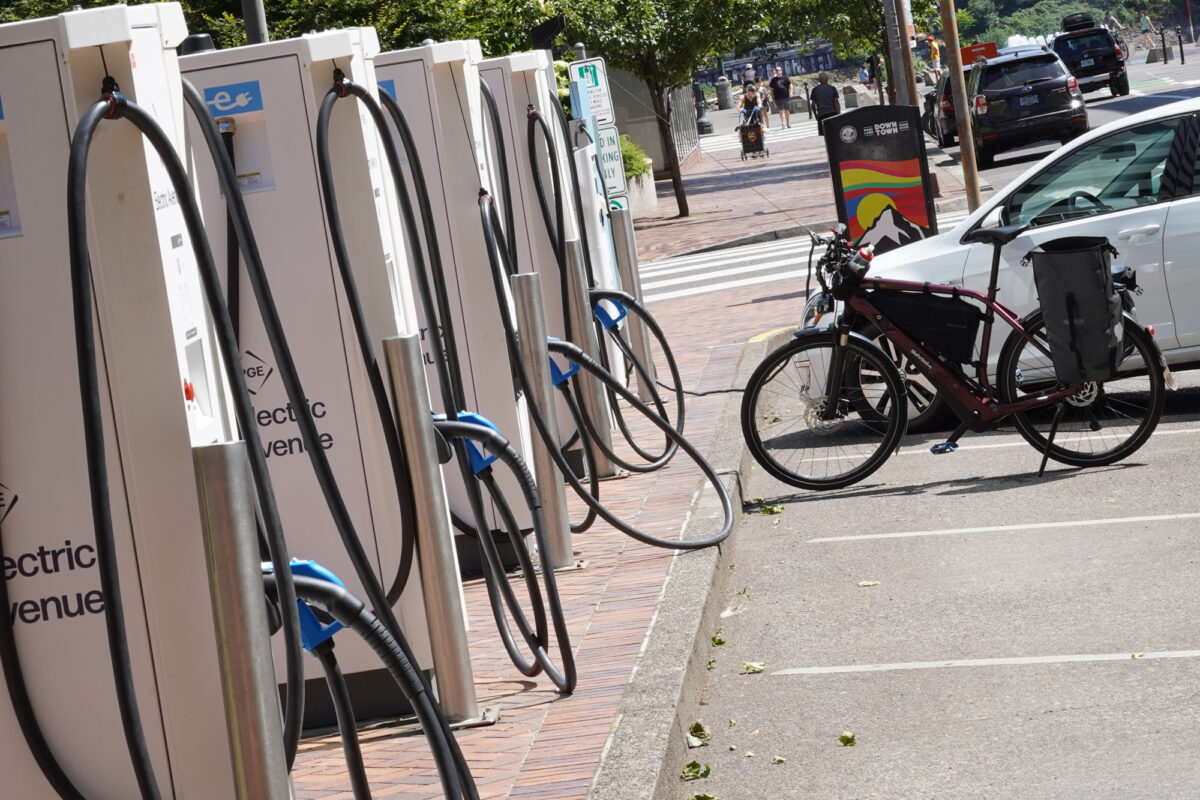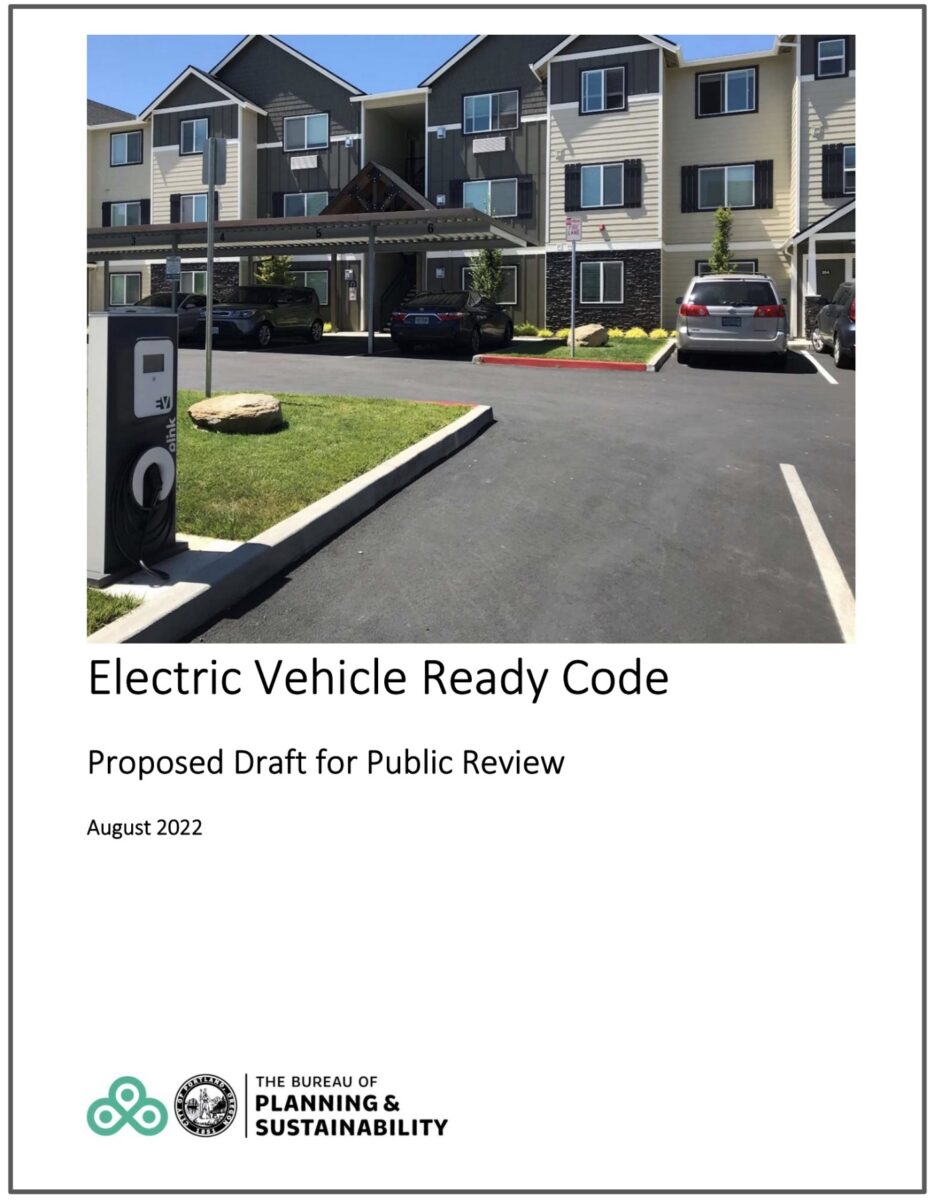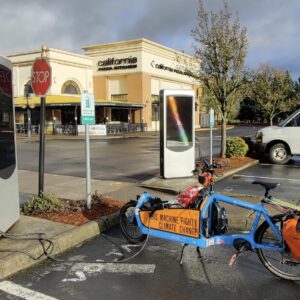
Last week, the Portland Bureau of Planning and Sustainability (BPS) released a new draft proposal for its Electric Vehicle Ready Code project, which would amend city zoning code to require electric vehicle charging at new multi-unit dwellings. But advocates for electric bikes – who frequently lament being left out of efforts to expand electric vehicle usage – will notice bikes are missing from the equation yet again.
As we pointed out when we looked at the discussion draft for this code amendment back in May, the plan acknowledges there is a need for alternative forms of transport, like electric bikes, to substitute for car trips in order for the city to meet its climate goals.
“Fundamentally, the number of private vehicles must decrease, the distance travelled must shrink, and alternative forms of electric transport (including electric buses, electric- scooters and electric bikes) must substitute for car trips,” the document states.
But that’s where the conversation ends. Neither the discussion draft nor the most recent draft proposal provides a plan for less private vehicle ownership and more e-bike usage through added charging facilities.
Even with tax credits for electric cars, these vehicles can be prohibitively expensive for broad adoption. And although they’re certainly better for the environment than cars that burn gasoline, e-cars have their pitfalls. E-bikes can serve as transformative, climate-friendly car replacements – but only if people can easily use them.
The crux of the plan is to require new multi-unit and mixed use developments with five or more units to provide the conduit for electric car charging infrastructure at 100% of parking spaces if the complex provides six spaces or less, or 50% of spaces when more than six are provided. The amendment won’t require developments to include parking spaces – but if they do, they need to follow these rules.
The lack of access to charging facilities for all electric vehicles – cars and bikes – impacts people of color and people who make low-incomes the most. As such, this impedes on the city’s equity goals, which is something they’re trying to tackle with this amendment.
“Access to EV-charging facilities in multifamily housing is key to ensuring equitable access,” the document states. “Renters…represent a greater portion of low- and moderate-income and Black, Indigenous, and People of Color (BIPOC) households. To date, these households have largely been unable to benefit from electric vehicles.”
“It’s kind of ridiculous that we’re bending over backwards to support cars but we’re not doing anything for e-bikes when the environmental benefits of e-bikes are so high.”
– Chris Smith
It’s true that people who live in multi-unit dwellings have a more difficult time accessing charging facilities for electric vehicles. But the logic applied to electric cars in the draft document, which states the “adoption of electric vehicle use is slowed by lack of familiarity and concerns about the availability of charging infrastructure,” also applies to electric bikes.
People who live in apartment or condo complexes may not be able to lug their bike to their unit to charge it if the battery isn’t removable, and the bikes can take up a lot of space in a small home. Having accessible charging infrastructure would make e-bikes easier to use for a lot of people.
It’s worth asking if e-bike owners would actually use charging facilities if they were provided alongside e-car charging in multi-unit dwellings. Portland’s major 2019 bike parking reform made it a requirement for bike parking – and outlets – to be included in many new multi-unit dwelling developments, so people should have access to more optimal places to charge them than in a parking lot with questionable security. But e-bike charging infrastructure needs deserve the level of attention electric car charging receives, so advocates say they should at least be included in the discussion for policies like this.
“My reaction is that it’s disappointing and kind of ridiculous that we’re bending over backwards to support cars but we’re not doing anything for e-bikes when the environmental benefits of e-bikes are so high,” Chris Smith, a Portland transportation activist and former member of the Planning and Sustainability Commission, told me.
People who use e-bikes as their primary means of transportation often need to get creative with charging solutions. The Oregon Department of Transportation has outfitted new electric vehicle charging stations with e-bike charging capacity, which is a small step toward e-bike accessibility, but does nothing to help bring easier charging closer to where people live.
Beyond the infrastructure itself, any time we update city code it’s an opportunity for government to send a message that they support and encourage non-car transportation, which in turn impacts whether or not the population at-large views e-bikes as a viable car alternative.
The next step in adopting this plan will be a BPS hearing on September 13, which will be open for public testimony. You can register to testify at the draft hearing here.







Thanks for reading.
BikePortland has served this community with independent community journalism since 2005. We rely on subscriptions from readers like you to survive. Your financial support is vital in keeping this valuable resource alive and well.
Please subscribe today to strengthen and expand our work.
Wow!…I am speechless at this “gap”…until we hear otherwise from those involved, it is a perverse disregard of understanding both the marketplace AND the difficulty of recharging (less technical but more of a security and access issue.) Plus there is the little ol’ thing called climate crisis. These buildings should have a 50 to 100 year lifespan…so baking in a lack of access is going to be an expensive retrofit problem.
At Bikestation, we had customers asking for secure parking + a secure place to recharge since at least 2012…so this should not surprise anyone in the business.
At this point in time it is not an oversight but a disregard. Yes, this may be a greater immediate impact to middle class and the wealthier bike owners, but used ebikes are beginning to be affordable by all…I just bought our family its first ebike…a third-hand bike for ~$300…pretty affordable…but still something I would not leave out in a shared space to recharge (due to its replacement cost of the batteries etc.)
Do a lot of ebikes have non-removable batteries? All the ones I’ve seen were easily removable and that’s how I’d prefer to charge. Maybe older bikes had more integrated batteries?
Many new e-bikes do not have removable batteries. This does not mean they are not swap-able in a shop, of course. The advantage of having a lighter in-frame battery is that they can be ridden without e-assist and can be carried up/down apartment stairs.
They are not significantly lighter, at least 90% of the weight of the battery is the cells themselves which you can’t avoid by integrating it into the frame, and whether it is integrated has nothing to do with if you can carry it up stairs or ride without e-assist. So is that the reason people buy these things? Misconceptions about weight or e-assist?
My 27 lb e-bike is “significantly” lighter than the 90 lb rad runner type bike. Why did I purchase a 27 lb e-bike? Due to DISABILITY I am not be able to carry a 90 lb bike up and down the stairs in my apartment.
Yes, different bikes weigh different amounts. But a 600wh battery weighs like 8 pounds, which your 27 pound bike must include because you can’t make batteries any lighter. So the 90 pound bike is 90 pounds because of something else, not the battery being external.
I’m not here to debate why it’s hard to carry a 90 pound bike up stairs. My point is there is no reason to make a bike need to be carried up the stairs at all. The rad bike has a removable battery that weighs a heck of a lot less than 27 pounds and is less cumbersome. You carry that up the stairs. By all measures that is a better option. They should all have removable batteries, and most do. I’m sure the *marketing* copy will say they have integrated batteries for weight savings, as a phony selling point, the way they try to sell you on shaving a half pound off the weight of a rim or something. They’re advertising features to sell you a thing you don’t need. It makes sense for the Tour de France but not for commuters. Not for practical use.
I have a 3.6 lb 250 wh battery in my 27 lb bike. This is typical for in-frame battery bikes that do not require the bulky metal overbuilt frames, massively overbuilt wheels, and massive high torque engines commonly found in bikes with 600 wh batteries.
And where do you suggest I store this bike? Do you have any understanding what it’s like to live in Portland’s substandard rental housing?
I use my e bike for commuting to work when my chronic disability makes it difficult or impossible to use my conventional commuter bikes. The take that my fendered and swept-handlebar city e-bike is only useful for the “Tour de France” is pure ableist nonsense. (I also have an e-scooter for when I can’t ride a bike at all.)
Well now you’re talking about parking which is besides the point. The topic of this article and comment is charging batteries, which has nothing to do with parking. If you’re taking your bike into your home anyway, charging infrastructure makes no difference to you.
It is absolutely indisputable that it is easier to carry your batteries into your home than your whole bike. So the weight of the bike is completely irrelevant. The fact that marketing convinces people that a pound here or there is going to make riding any easier (and worth buying more things!) just says more about the insidiousness of advertising.
Fact is, your bikes weigh different amounts because they’re different styles of bike. Not because one has removable batteries or not. Your 27 pound bike would be like 28 pounds if it had a removable battery, consisting of an aluminum or plastic battery case and mounting bracket. Your 90 pound bike is just a bigger heavier bike, probably with a much bigger battery.
You’re simply trying to misrepresent what I said. That’s not what I said, not even close. I said the difference of a couple pounds (which is what you save with non-removable batteries) is only important for things like the Tour de France. Your light weight bike can be just as light within a rounding error with a removable battery. The rounding error doesn’t matter for practical purposes.
Regardless, you’re dragging this comment thread way into the weeds and off topic for what appears to be the thrill of arguing.
Your 27 pound bike would be like 28 pounds if it had a removable battery,
So I’m sure you can provide me a link that documents this imaginary 28 lb e-bike with a removable battery.
Another ableist strawman, I have two chronic disabilities and am not able to lug a heavy bike into my apartment.
Ok, I have to assume bad faith trolling now. You have again lied and tried to say I’m suggesting people carry bikes into their house. I suggested the literal exact opposite.
Goodnight. I know I agree with you politically for the most part so it’s annoying to find that you’re mostly on here to troll.
What kind is this 27 lb e-bike and how much did it cost? I might downsize since I’m not hauling the kiddo on the back anymore.
“People who live in apartment or condo complexes may not be able to lug their bike to their unit to charge it if the battery isn’t removable, and the bikes can take up a lot of space in a small home.”
Well, the obvious solution is to require apartment and condo complexes to have elevators (big enough to accommodate electric cargo bikes) and to have a minimum size (maybe 1200 square feet). That ought to help push up the price of apartments to $2500 per month and condos to $700,000. Then, to offset those prices, we can institute a new tax to make Portland more affordable. The new tax (as yet unspecified) can be used to help drive more people out of Portland.
Where does it end? Do we have to legislate everything?
We do have to legislate things like this because the free market is an utter failure at doing things like this. The “free market” is how you get suburbs and us drowning in car dependent infrastructure and CO2. It’s what got us into this mess.
No. The legislation (zoning codes) that required massive amounts of parking caused the proliferation of auto traffic and suburbs. Read Donald Shoup’s The High Cost of Free Parking.
I don’t know how the solution to bad legislation wouldn’t be more legislation. I don’t know how that could be controversial even to a libertarian.
This article his the nail on the head. I leave my (thoroughly locked up and insured) pedal assist ebike in the bike room of my apartment building, but detach the battery to take it upstairs to charge. I knew going into it that I’d want a removable battery because there are no outlets in the bike room.
In addition to providing places for ebike owners to charge in new buildings, do ya’ll think it would be worthwhile to require that ebikes have removable batteries? All the tech bro startup ebikes like Vanmoof and the like have batteries integrated in the frame. Seems like the motor and electronics will probably outlast the battery. Not to mention the frame and bike components! My acoustic bike was built in the 70’s and still runs like a champ. It’s at least easier to swap out and recycle the batteries when they do go out.
Careful…using “acoustic” to describe a bicycle might (will) trigger quite a few folks around here.
I don’t think it makes sense to have ebike charging right next to electric cars. In addition to security, why would I want to store my bike potentially out in the weather? There is no standard ebike charger yet, and my charger is most definitely not waterproof. There is already bike parking with outlets, and (most?) ebikes have removable batteries as well.
There is a bike parking issue, but this isn’t it. We need to require all businesses to have bike parking. Why is there not a place for me to lock my bike at my local cafe? Or when I rented kayaks down in South Portland, there was to no bike racks nearby to lock bikes to. I don’t want to have to try to use google streetview every time I visit someplace new to make sure they have bike parking.
Pretty sure most rental units come with 120VAC outlets.
Many people are not able to carry a 70+ lb e-bike up the stairs to/from their apartment. I think you would also be surprised how many rental units have “deferred maintenance”* and have dangerous ungrounded 120V outlets (sometimes without a modern circuit breaker) that trip e-bike charger circuitry.
* Landlord for I don’t care if my tenants live in unsafe/dangerous housing because it’s all about the benjamins.
I don’t want to be one of those people who complains about whether this is a high priority or not, but honestly I don’t think I would ever use bike charging infrastructure. Although it’s totally different if you have a non removable battery, but those shouldn’t even exist. Any ebike I’ve seen had a trivially removable battery and it would be the most convenient option to charge.
And as others noted, I don’t think the chargers are standardized yet. Maybe they are, not sure.
I suppose if an apartment complex required indoor bike parking, and that parking had chargers, I’d use that. It would be nice but almost a trivial convenience.
I agree that ebikes, especially cargo ones, are transformative. Way better than cars.
What do others think, it what am I missing? What’s the point of bike charging infrastructure?
It’s amusing that people who e-cycle are jealous of public chargers that often cannot be activated using an RFID or credit card, often are out of service, are 3-6x as expensive as residential power, use incompatible apps with mandatory $10 block charging, and sometimes ooze black foetid tar (wish this was a joke).
Not sure it’s legal for the City to require it for bikes. This is a sticky wicket, where Oregon has a state building code, and there are a limited number of carve-outs on what cities can do on top of it.
One of those carve outs is in ORS 455.417, which was passed in 2021, and allows cities to require more than 20% conduit for EV charging for cars.
<i>(4) Notwithstanding ORS 455.040, a municipality may, by process concerning land use, require that each newly constructed building described in subsection (3)(a) of this section include provisions for electrical service capacity to accommodate more than 20 percent of vehicle parking spaces in the garage or parking area for the building. [2021 c.152 §1]</i>
A call to the city would clear this up.
It says vehicles, not cars. I think the laws would apply to bikes.
You might be right. On the other hand, the requirement would be a zoning code requirement. The City often imposes requirements through the zoning code that require people to exceed the building code. For instance, the zoning code has minimum window area requirements that require far more windows than the building code, door location requirements that require doors where the building code doesn’t, etc.
Rather than worry abou how to legislate accommodating those who apparently buy ebikes without considering their own charging needs, a far more worthwhile thing to worry about would be bike facilities that provide reasonable security.
Ebikes have been around for a long time and largely have the same issues as other kinds of cycles — size, weight, speed. Not sure why they should suddenly have a special priority.